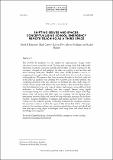Files in this item
Shifting selves and spaces : conceptualising school emergency remote teaching as a third space
Item metadata
| dc.contributor.author | Johnston, David | |
| dc.contributor.author | Carver, Mark | |
| dc.contributor.author | Foy, Katrina | |
| dc.contributor.author | Mulligan, Aloyise | |
| dc.contributor.author | Shanks, Rachel | |
| dc.date.accessioned | 2022-06-15T10:30:07Z | |
| dc.date.available | 2022-06-15T10:30:07Z | |
| dc.date.issued | 2022-05-30 | |
| dc.identifier | 280066526 | |
| dc.identifier | 3fbaca2e-d48b-49e0-99af-ff8abf941023 | |
| dc.identifier.citation | Johnston , D , Carver , M , Foy , K , Mulligan , A & Shanks , R 2022 , ' Shifting selves and spaces : conceptualising school emergency remote teaching as a third space ' , Journal of Digital Social Research , vol. 4 , no. 2 , pp. 26-46 . https://doi.org/10.33621/jdsr.v4i2.109 | en |
| dc.identifier.other | Bibtex: johnston2022shifting | |
| dc.identifier.other | ORCID: /0000-0003-4393-8915/work/114641120 | |
| dc.identifier.uri | https://hdl.handle.net/10023/25533 | |
| dc.description | The British Educational Research Association provided COVID-19 small research project fundingfor one of the research studies. | en |
| dc.description.abstract | The COVID-19 pandemic was the catalyst for unprecedented change within education systems around the world. Teaching and learning which had traditionally taken place in school classrooms suddenly moved online. Teachers’ responses to the emergency changed not just pedagogy but who was teaching as well as when and where teaching took place. Bhabha’s ‘third space’ (1994) provides a way of re-imagining the new spaces (both physical and virtual) which were created in response to the pandemic. We report on data from two research studies in Scotland conducted in the 2020-21 academic year covering two lockdown (stay at home) periods: one comprising interviews with nine educators in Scotland; the other study using two rounds of focus groups with eleven early career teachers. Our research thus enquires into the lockdown practices of a range of teachers and managers across different local authorities in Scotland, exploring how they engaged learners using digital technologies during two national lockdowns. Across both studies, digital technology played a key role in how this third space was mediated and the findings show participants’ emotional highs and lows of working within this new space. It also shows teachers’ changing perceptions of children and families and how power relations evolved over the lockdown periods. Technology facilitated the emergency response, but questions remain as to what the legacy of this forced shift will be. This paper points to the importance of two-way communication between home and school and how third spaces using digital technologies could bring home and school funds of knowledge closer together. | |
| dc.format.extent | 21 | |
| dc.format.extent | 478131 | |
| dc.language.iso | eng | |
| dc.relation.ispartof | Journal of Digital Social Research | en |
| dc.subject | Digital third space | en |
| dc.subject | Home/school links | en |
| dc.subject | Emergency remote teaching | en |
| dc.subject | Pandemic pedagogies | en |
| dc.subject | The third self | en |
| dc.subject | COVID-19 | en |
| dc.subject | LB Theory and practice of education | en |
| dc.subject | NIS | en |
| dc.subject | NCAD | en |
| dc.subject.lcc | LB | en |
| dc.title | Shifting selves and spaces : conceptualising school emergency remote teaching as a third space | en |
| dc.type | Journal article | en |
| dc.contributor.institution | University of St Andrews. International Education Institute | en |
| dc.identifier.doi | 10.33621/jdsr.v4i2.109 | |
| dc.description.status | Peer reviewed | en |
This item appears in the following Collection(s)
Items in the St Andrews Research Repository are protected by copyright, with all rights reserved, unless otherwise indicated.

